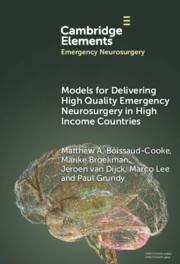Element contents
Models for Delivering High Quality Emergency Neurosurgery in High Income Countries
Published online by Cambridge University Press: 06 January 2024
Summary
- Type
- Element
- Information
- Online ISBN: 9781009366113Publisher: Cambridge University PressPrint publication: 01 February 2024
References
- 1
- Cited by



